Genre: Sports Developer: Sandcastle Productions Publisher: Electronic Arts Players: 1-2 Released: 1990
Miniature golf beyond your wildest imagination! It reads so right there on the box. Wow. If there ever was something that read like a contradiction in itself, that would probably be it. You have to admit one thing, though: It sounds like a rather unique premise.
So, let’s travel back a bit to the Genesis of the… well, Genesis. Zany Golf was originally created in 1988 for the Apple II, Amiga, and IBM PC with modest success. In 1990, it became the third game ported by Electronic Arts to the fledgling console. As the story goes, it was one of three games (after Budokan and Populous) that EA created after reverse-engineering Sega’s new flagship and was a key in the company’s successful negotiations to gain a better licensing deal. Apparently, since the game was already finished, it was released as is, even without having been created with an official developing kit. Later revisions had to be re-issued because they wouldn’t run after Sega implemented their Trademark Security System (TMSS).
Zany Golf wasn’t an overly complex game to begin with, and keeping the above in mind, it’s little surprise that the Genesis port also comes off as a rather simplistic title. Given the input methods of the console, one track of the mini golf course had to be omitted as well. More on that later.
So, what is Zany Golf anyway? Well, it’s sort of a mini golf simulator, but not quite. Given the situation that this is a video game, elements have been included that put the player in situation he could physically never encounter in a real course. So basically, while the main goal is still that of a game of golf ?? get the ball into a hole per course in a minimum amount of strokes ?? the track is in many places outfitted with either interactive elements or crazy obstacles that give more of a twist to the game and make the puzzling more interesting.
Each of the nine tracks plays differently and makes the game rather enjoyable. To aim, you first focus crosshair on your ball (which you can do automatically by hitting the B Button). By holding down A and moving the D-pad away from the direction you want the ball to go you can determine angle and strength of the hit. It takes a little while to get used to, but you get the hang of it rather quickly. Depending on the difficulty, you have a certain number of strokes you are allowed to stay over par. Stay on par or below, and you gain access to the ninth and final track. Run out of tries, and it’s game over.
The first hole is a rather standard mini golf fare (the classic windmill scenario), but other tracks employ a variety of interactive obstacles that give the controls a more arcade-like spin while the ball is rolling. On one course you have to repeatedly bounce a hamburger that is lying on top of the hole into the air for the ball to go in. Yes, that sounds strange, but then again the game IS called Zany Golf. Other examples include fans then have to be spun manually by rotating the D-Pad (the faster the rotation, the stronger the airflow) which have to be utilized in order to blow your ball in the right direction, a track that is basically a pinball machine (where you operate the flippers) or a hole where you have to clear out obstacle in a Breakout clone before you can clear your path towards the goal. Since the Genesis is (or rather, originally was) lacking a mouse, one hole had to be left out of the overall course since in its original computer incarnation it granted you mouse-control over the ball, something that apparently couldn’t be properly translated to control pads.
While this is pretty entertaining, the fun factor is rather ruined by the presentation. The game hasn’t aged well, and what in 1990 might have only counted as mild annoyances can nowadays rather ruin the game. Most apparent is the tediously slow scrolling. The crosshair moves very sluggishly, making it feel like an eternity if you only want to scroll around and get an overall view of the field. The flow of the game is very slow and sometimes very jerky, which becomes painfully apparent in the pinball stage, where properly aiming the ball becomes rather impossible, and a missed shot can take forever to come to a stop and grant you a new try. Action it ain’t. Graphics don’t win a prize either. They do look rather nice, but they are of a rather low quality and feel more like they would belong to a Master System rather than a Genesis-title at times.
What really tore away at my nerves, however, was the sound! While slow soothing muzak seems rather appropriate for a mini golf game, the quality and repetitiveness of every single track makes you reach for the volume knob after only a little while. Since there hardly are any sound effects you’d miss out on (and those that are in the game are dull and uninteresting), you’d do better to just shut the sound off completely and rather turn on the radio. The in-game music is really annoying and hurts the game big time!
Looking at the game at hand, you certainly get a certain vibe from it making it believable that this was originally an unlicensed effort ?? the slow flow of the game and sub-par presentation sure hint at such origins. The game itself isn’t that bad and at times can become fun and entertaining. At nine holes, it is a pretty short effort, which could invite for a few quick holes. But watching the screen jerk around, witnessing the ball creep along at a snail’s pace and listening to the music eating away at your eardrums make you reach for the power button before you’re halfway though. It has its moments, but overall, it’s not worth the effort of hunting down.
SCORE: 4 out of 10

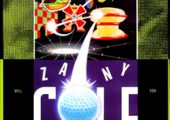
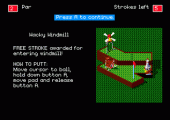
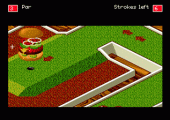
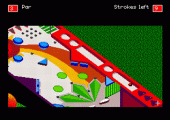
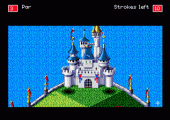
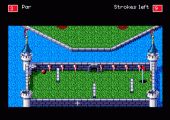
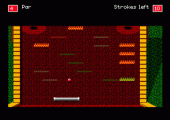
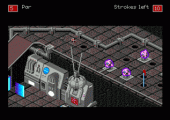
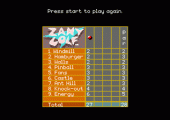
Recent Comments